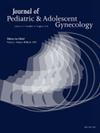27. Diagnosis of Imperforate Hymen: A Case Study for Quality Improvement
IF 1.8
4区 医学
Q3 OBSTETRICS & GYNECOLOGY
引用次数: 0
Abstract
Background
Imperforate hymen, transverse vaginal septum, vaginal agenesis, and lower vaginal atresia are four common forms of vaginal outlet obstruction. Early differentiation between these anatomic variants is crucial to determine a correct diagnosis and ensure appropriate surgical timing to avoid unnecessary surgical revision or complication. Distinguishing between these variants relies initially on physical exam. When characteristic components are absent, it is critical to obtain imaging to distinguish between other obstructive vaginal anomalies as the presence of hematocolpos or hematometra may occur with many types of obstructive mullerian anomalies. A pelvic ultrasound may be ordered initially as it is more readily available but may not yield enough detailed information. In this circumstance, further imaging should be obtained prior to surgical intervention with Pelvic MRI; the gold standard imaging modality for reproductive tract anomalies. This case reminds the provider of the steps to take for the correct diagnosis as well as recommendations for specialist referral when the presentation is not that of a bulging membrane with blue hue at the introitus.
Case
A 13 yo female presented to an outside emergency room with severe, cyclic abdominopelvic pain. A pelvic ultrasound suggested hematometra. She was taken to the operating room due to pelvic exam findings concerning for no vaginal patency. A vaginal dimple was present without blue hue or bulging noted. Intraoperatively, an incision did not reveal release of menstrual contents. The surgery was aborted due to findings inconsistent with imperforate hymen. MRI Pelvis was ordered later and a diagnosis of cervicovaginal agenesis with hematometra was made. Menstrual suppression was then initiated with GnRh antagonist orally. A few years later, the patient was referred to Pediatric and Adolescent Gynecology.
Comments
For complex reproductive tract anomalies, pelvic MRI should be ordered following pelvic US as MRI best correlates with the type of anomaly. Avoid going to the operating room if the classic presentation of imperforate hymen is not visualized and confirmed to minimize complications. Optimize pain management to allow time to obtain adequate MRI Pelvis with contrast for optimal delineation of hymenal versus other vaginal and mullerian variants. This includes assessing distance from introitus to defect. Refer to a specialist with expertise in managing obstructive reproductive tract anomalies, when an anomaly other imperforate hymen is suspected.
27.处女膜穿孔的诊断:质量改进案例研究
背景:处女膜穿孔、阴道横隔、阴道发育不全和阴道下段闭锁是阴道出口梗阻的四种常见形式。早期鉴别这些解剖变异对于确定正确的诊断和确保适当的手术时机以避免不必要的手术翻修或并发症至关重要。区分这些变体最初依赖于体检。当特征成分缺失时,获得影像学检查以区分其他梗阻性阴道异常是至关重要的,因为许多类型的梗阻性苗勒管异常都可能出现结肠或血肿。盆腔超声可能会在一开始进行,因为它更容易获得,但可能不能提供足够的详细信息。在这种情况下,应在手术前进行骨盆MRI进一步成像;生殖道异常的金标准成像方式。这个病例提醒提供者采取正确诊断的步骤,以及建议专家转诊,当表现不是鼓鼓的膜与蓝色色调在开端。病例a: 13岁,女性,因严重的周期性腹部骨盆疼痛被送往外部急诊室。盆腔超声提示有血肿。由于骨盆检查发现没有阴道通畅,她被送往手术室。阴道有酒窝,无蓝色或隆起。术中,切口未发现月经内容物的释放。手术因发现与处女膜闭锁不符而流产。随后行骨盆MRI检查,诊断为宫颈阴道发育不全伴积血。然后口服GnRh拮抗剂开始月经抑制。几年后,病人被转到儿科和青少年妇科。对于复杂的生殖道异常,应在盆腔超声检查后进行盆腔MRI检查,因为MRI与异常类型最相关。如果处女膜闭锁的典型表现没有被可视化和确认,避免去手术室,以减少并发症。优化疼痛处理,以便有时间获得充分的骨盆MRI对比,以最佳描绘处女膜与其他阴道和苗勒管变异。这包括评估从内向到叛变的距离。当怀疑有其他处女膜闭锁异常时,请咨询有治疗梗阻性生殖道异常经验的专家。
本文章由计算机程序翻译,如有差异,请以英文原文为准。
求助全文
约1分钟内获得全文
求助全文
来源期刊
CiteScore
3.90
自引率
11.10%
发文量
251
审稿时长
57 days
期刊介绍:
Journal of Pediatric and Adolescent Gynecology includes all aspects of clinical and basic science research in pediatric and adolescent gynecology. The Journal draws on expertise from a variety of disciplines including pediatrics, obstetrics and gynecology, reproduction and gynecology, reproductive and pediatric endocrinology, genetics, and molecular biology.
The Journal of Pediatric and Adolescent Gynecology features original studies, review articles, book and literature reviews, letters to the editor, and communications in brief. It is an essential resource for the libraries of OB/GYN specialists, as well as pediatricians and primary care physicians.

 求助内容:
求助内容: 应助结果提醒方式:
应助结果提醒方式:


